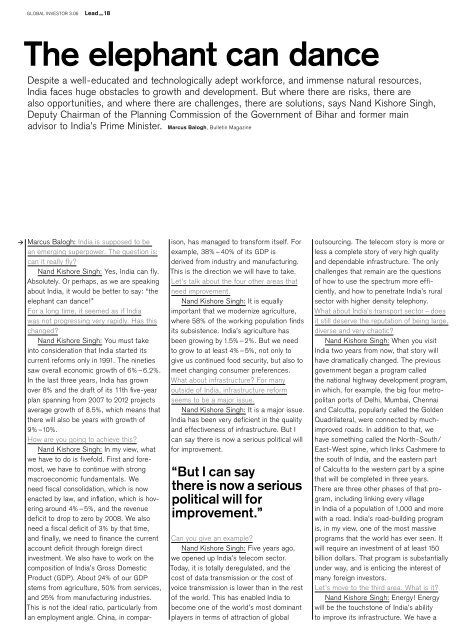Banking for 7 billion and 7 million
New challenges and opportunities of globalization Global Investor, 03/2006 Credit Suisse
New challenges and opportunities of globalization
Global Investor, 03/2006
Credit Suisse
You also want an ePaper? Increase the reach of your titles
YUMPU automatically turns print PDFs into web optimized ePapers that Google loves.
GLOBAL INVESTOR 3.06 Lead — 18<br />
The elephant can dance<br />
Despite a well-educated <strong>and</strong> technologically adept work<strong>for</strong>ce, <strong>and</strong> immense natural resources,<br />
India faces huge obstacles to growth <strong>and</strong> development. But where there are risks, there are<br />
also opportunities, <strong>and</strong> where there are challenges, there are solutions, says N<strong>and</strong> Kishore Singh,<br />
Deputy Chairman of the Planning Commission of the Government of Bihar <strong>and</strong> <strong>for</strong>mer main<br />
advisor to India’s Prime Minister. Marcus Balogh, Bulletin Magazine<br />
<br />
Marcus Balogh: India is supposed to be<br />
an emerging superpower. The question is:<br />
can it really fly?<br />
N<strong>and</strong> Kishore Singh: Yes, India can fly.<br />
Absolutely. Or perhaps, as we are speaking<br />
about India, it would be better to say: “the<br />
elephant can dance!”<br />
For a long time, it seemed as if India<br />
was not progressing very rapidly. Has this<br />
changed?<br />
N<strong>and</strong> Kishore Singh: You must take<br />
into consideration that India started its<br />
current re<strong>for</strong>ms only in 1991. The nineties<br />
saw overall economic growth of 6% – 6.2%.<br />
In the last three years, India has grown<br />
over 8% <strong>and</strong> the draft of its 11th five-year<br />
plan spanning from 2007 to 2012 projects<br />
average growth of 8.5%, which means that<br />
there will also be years with growth of<br />
9% – 10%.<br />
How are you going to achieve this?<br />
N<strong>and</strong> Kishore Singh: In my view, what<br />
we have to do is fivefold. First <strong>and</strong> <strong>for</strong>emost,<br />
we have to continue with strong<br />
macroeconomic fundamentals. We<br />
need fiscal consolidation, which is now<br />
enacted by law, <strong>and</strong> inflation, which is hovering<br />
around 4% – 5%, <strong>and</strong> the revenue<br />
deficit to drop to zero by 2008. We also<br />
need a fiscal deficit of 3% by that time,<br />
<strong>and</strong> finally, we need to finance the current<br />
account deficit through <strong>for</strong>eign direct<br />
investment. We also have to work on the<br />
composition of India’s Gross Domestic<br />
Product (GDP). About 24% of our GDP<br />
stems from agriculture, 50% from services,<br />
<strong>and</strong> 25% from manufacturing industries.<br />
This is not the ideal ratio, particularly from<br />
an employment angle. China, in compar-<br />
ison, has managed to trans<strong>for</strong>m itself. For<br />
example, 38% – 40% of its GDP is<br />
derived from industry <strong>and</strong> manufacturing.<br />
This is the direction we will have to take.<br />
Let’s talk about the four other areas that<br />
need improvement.<br />
N<strong>and</strong> Kishore Singh: It is equally<br />
important that we modernize agriculture,<br />
where 58% of the working population finds<br />
its subsistence. India’s agriculture has<br />
been growing by 1.5% – 2%. But we need<br />
to grow to at least 4% – 5%, not only to<br />
give us continued food security, but also to<br />
meet changing consumer preferences.<br />
What about infrastructure? For many<br />
outside of India, infrastructure re<strong>for</strong>m<br />
seems to be a major issue.<br />
N<strong>and</strong> Kishore Singh: It is a major issue.<br />
India has been very deficient in the quality<br />
<strong>and</strong> effectiveness of infrastructure. But I<br />
can say there is now a serious political will<br />
<strong>for</strong> improvement.<br />
“But I can say<br />
there is now a serious<br />
political will <strong>for</strong><br />
improvement.”<br />
Can you give an example?<br />
N<strong>and</strong> Kishore Singh: Five years ago,<br />
we opened up India’s telecom sector.<br />
Today, it is totally deregulated, <strong>and</strong> the<br />
cost of data transmission or the cost of<br />
voice transmission is lower than in the rest<br />
of the world. This has enabled India to<br />
become one of the world’s most dominant<br />
players in terms of attraction of global<br />
outsourcing. The telecom story is more or<br />
less a complete story of very high quality<br />
<strong>and</strong> dependable infrastructure. The only<br />
challenges that remain are the questions<br />
of how to use the spectrum more efficiently,<br />
<strong>and</strong> how to penetrate India’s rural<br />
sector with higher density telephony.<br />
What about India’s transport sector – does<br />
it still deserve the reputation of being large,<br />
diverse <strong>and</strong> very chaotic?<br />
N<strong>and</strong> Kishore Singh: When you visit<br />
India two years from now, that story will<br />
have dramatically changed. The previous<br />
government began a program called<br />
the national highway development program,<br />
in which, <strong>for</strong> example, the big four metropolitan<br />
ports of Delhi, Mumbai, Chennai<br />
<strong>and</strong> Calcutta, popularly called the Golden<br />
Quadrilateral, were connected by muchimproved<br />
roads. In addition to that, we<br />
have something called the North-South/<br />
East-West spine, which links Cashmere to<br />
the south of India, <strong>and</strong> the eastern part<br />
of Calcutta to the western part by a spine<br />
that will be completed in three years.<br />
There are three other phases of that program,<br />
including linking every village<br />
in India of a population of 1,000 <strong>and</strong> more<br />
with a road. India’s road-building program<br />
is, in my view, one of the most massive<br />
programs that the world has ever seen. It<br />
will require an investment of at least 150<br />
<strong>billion</strong> dollars. That program is substantially<br />
under way, <strong>and</strong> is enticing the interest of<br />
many <strong>for</strong>eign investors.<br />
Let’s move to the third area. What is it?<br />
N<strong>and</strong> Kishore Singh: Energy! Energy<br />
will be the touchstone of India’s ability<br />
to improve its infrastructure. We have a

















